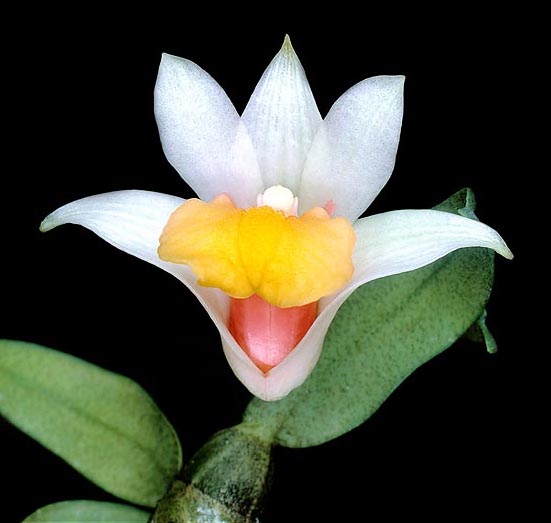Family : Orchidaceae

Text © Pietro Puccio

English translation by Mario Beltramini

Dendrobium bellatulum smiling flower seems come out from a tale © Giuseppe Mazza
The name of the genus is the combination of the Greek terms “déndron” = tree and “bios” = life, with reference to the numerous species of the genus living on the trees; the name of the species is the Latin adjective “bellatulus”, from “bellus” = beautiful.
Common names: ai shi hu (Chinese).
The Dendrobium bellatulum Rolfe (1903) is an epiphytic species with oblong-fusiform pseudobulbs, of 2-8 cm of length and about 1,6 cm of diameter, with 2-4 oblong leaves, coriaceous, 1,5-4,5 cm long and 0,5-1,5 cm broad, initially covered, like the pseudobulbs, by a thick and short black down. The inflorescence is usually solitary, axillary, sub terminal, carrying 1-3 perfumed flowers, of 3-5 cm of diameter, with cream white sepals and petals.
The dorsal sepal is oblong with pointed apex, about 2 cm long and 1 cm broad, the lateral ones are triangular with pointed apex, about 2,5 cm long and 1 cm broad. The labellum is trilobed, 2,5-3 cm long, with bright red lateral lobes, and median lobe slightly bilobed, gold yellow or orange, with the extremity partially retroflexed. It reproduces by seed, in vitro, and by division, with each section provided of at least 4-5 pseudobulbs.
It is a tiny orchid with long-lasting flowers, about one month, almost bigger than the plant itself and where the intensely coloured labellum stands out.
It requires a luminous position, regular waterings, high humidity and medium-high temperatures during the vegetative period in spring-summer, in autumn-winter the waterings are to be reduced until being almost stopped, avoiding however to have the pseudobulbes too much wrinkled, positioning the plant in a cool and much luminous location, also direct sun for a few hours per day, with night temperatures of 10-14 °C; a good air circulation is essential in all seasons.
For the waterings and the nebulisations is to be used rain water, or water obtained by reverse osmosis or demineralised; the fertilizations, duly distributed and alternated, in way to avoid salts accumulations on the roots, are to be done during the vegetative period preferably with hydro-soluble balanced products, with microelements, at ¼ of dosage than what suggested on the package.
It is mounted preferably on bark, trunks, raft of cork or of roots of arborescent ferns in order to quickly dry up after the waterings, as it does not tolerate stagnations. Displacements and divisions are to be done at the moment when the new roots do appear.
The species is inscribed into the appendix II of CITES (species whose trade is internationally ruled).
→ For general notions about ORCHIDACEAE please click here.
